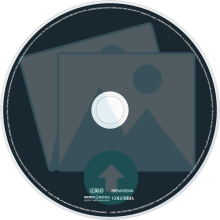
Cover NOT yet available in
Join up for 4K upload/download access
Your Rating (Click a star below)
![]()
![]()
![]()
![]()
![]()
![]()
![]()
![]()
![]()
![]()
Track List
01) He's a Rebel
02) Da Doo Ron Ron
03) Be My Baby
04) Then He Kissed Me
05) (Today I Met) The Boy I'm Gonna Marry
06) Baby, I Love You
07) He's Sure the Boy I Love
08) Zip-A-Dee-Doo-Dah
09) Wait Til' My Bobby Gets Home
10) Walking in the Rain
11) Uptown
12) Why Do Lovers Break Each Others Hearts?
13) Do I Love You?
14) A Fine, Fine Boy
15) There's No Other Like My Baby
16) You've Lost That Loving Feeling
17) (The Best Part of) Breakin' Up
18) Not Too Young to Get Married
19) River Deep—Mountain High
01) He's a Rebel
02) Da Doo Ron Ron
03) Be My Baby
04) Then He Kissed Me
05) (Today I Met) The Boy I'm Gonna Marry
06) Baby, I Love You
07) He's Sure the Boy I Love
08) Zip-A-Dee-Doo-Dah
09) Wait Til' My Bobby Gets Home
10) Walking in the Rain
11) Uptown
12) Why Do Lovers Break Each Others Hearts?
13) Do I Love You?
14) A Fine, Fine Boy
15) There's No Other Like My Baby
16) You've Lost That Loving Feeling
17) (The Best Part of) Breakin' Up
18) Not Too Young to Get Married
19) River Deep—Mountain High
2:32
2:22
2:42
2:40
2:48
2:53
2:45
2:51
2:26
3:17
2:22
2:52
2:57
2:48
2:31
3:44
3:06
2:31
3:33
Data Complete 60%
Total Rating
Total Rating
![]() (1 users)
(1 users)
Back Cover![]()
CD Art
3D Case
3D Thumb
3D Flat
3D Face
3D Spine
First Released
![]() 2011
2011
![]() Rock
Rock
![]() Gritty
Gritty
![]() Rock/Pop
Rock/Pop
![]() ---
---
![]() Medium
Medium
![]() Album
Album
![]() 0 copies
0 copies
Album Description
Available in:
Phil Spector was really more of a back-tier session musician, songwriter, and occasional producer when he started his own Philles Records imprint in 1961. He had some success, having written, played guitar, and sung backup vocals on 1958’s “To Know Him Is to Love Him” (which hit the top of the pop charts that year) as part of the Teddy Bears and he worked for a time as part of the production team for Leiber & Stoller, co-writing “Spanish Harlem” for Ben E. King and playing guitar on the Drifters' “On Broadway,” and he produced minor sides for LaVern Baker and Ruth Brown, among others, but there was really little to distinguish him from any number of other hopefuls clustered around the pop music scene as the 1960s dawned. But Spector was driven, single-minded, and stubborn, and he had a sound in his head. Now with his own label, he set out to record a series of singles he termed “little symphonies for the kids” that are among the most distinctive and influential recordings in the history of pop music. Combining massed pianos, guitars, string arrangements by Jack Nitzsche, tons of layered percussion, and huge washes of echo, working with the West Coast’s best session players (including Hal Blaine, Tommy Tedesco, Larry Knechtel, Leon Russell, and Harold Battiste -- the so-called Wrecking Crew), and leaning heavily on his engineer Larry Levine to catch all of this in the small confines of Gold Star Studios in Los Angeles, Spector developed his “Wall of Sound” production approach, controlling every aspect of the recordings until, even though he wasn’t singing or even playing any instrument, they became -- in essence -- Phil Spector records. This is not to diminish the singers he used -- Ronnie Bennett, Darlene Love, Tina Turner, and the Righteous Brothers, among others -- but a Spector recording in the 1960s was just that, a Spector recording. This 19-track set collects the best of his Philles releases, including the classics “He’s a Rebel,” “Da Doo Ron Ron,” and “There’s No Other Like My Baby” by the Crystals, “Be My Baby,” “Baby, I Love You,” “Walking in the Rain,” and “(The Best Part Of) Breakin' Up” by the Ronettes, the Righteous Brothers' “You’ve Lost That Lovin’ Feeling,” and Ike & Tina Turner's “River Deep, Mountain High.” Spector amassed a singular catalog at Philles between 1961 and 1966 and his legacy will always be linked to it -- for those five years, there was no one on earth making better-sounding pop records. The proof of that is collected here.

User Album Review
None...
External Album Reviews
None...
User Comments


Available in:
Phil Spector was really more of a back-tier session musician, songwriter, and occasional producer when he started his own Philles Records imprint in 1961. He had some success, having written, played guitar, and sung backup vocals on 1958’s “To Know Him Is to Love Him” (which hit the top of the pop charts that year) as part of the Teddy Bears and he worked for a time as part of the production team for Leiber & Stoller, co-writing “Spanish Harlem” for Ben E. King and playing guitar on the Drifters' “On Broadway,” and he produced minor sides for LaVern Baker and Ruth Brown, among others, but there was really little to distinguish him from any number of other hopefuls clustered around the pop music scene as the 1960s dawned. But Spector was driven, single-minded, and stubborn, and he had a sound in his head. Now with his own label, he set out to record a series of singles he termed “little symphonies for the kids” that are among the most distinctive and influential recordings in the history of pop music. Combining massed pianos, guitars, string arrangements by Jack Nitzsche, tons of layered percussion, and huge washes of echo, working with the West Coast’s best session players (including Hal Blaine, Tommy Tedesco, Larry Knechtel, Leon Russell, and Harold Battiste -- the so-called Wrecking Crew), and leaning heavily on his engineer Larry Levine to catch all of this in the small confines of Gold Star Studios in Los Angeles, Spector developed his “Wall of Sound” production approach, controlling every aspect of the recordings until, even though he wasn’t singing or even playing any instrument, they became -- in essence -- Phil Spector records. This is not to diminish the singers he used -- Ronnie Bennett, Darlene Love, Tina Turner, and the Righteous Brothers, among others -- but a Spector recording in the 1960s was just that, a Spector recording. This 19-track set collects the best of his Philles releases, including the classics “He’s a Rebel,” “Da Doo Ron Ron,” and “There’s No Other Like My Baby” by the Crystals, “Be My Baby,” “Baby, I Love You,” “Walking in the Rain,” and “(The Best Part Of) Breakin' Up” by the Ronettes, the Righteous Brothers' “You’ve Lost That Lovin’ Feeling,” and Ike & Tina Turner's “River Deep, Mountain High.” Spector amassed a singular catalog at Philles between 1961 and 1966 and his legacy will always be linked to it -- for those five years, there was no one on earth making better-sounding pop records. The proof of that is collected here.
User Album Review
None...
External Album Reviews
None...
User Comments

No comments yet...

